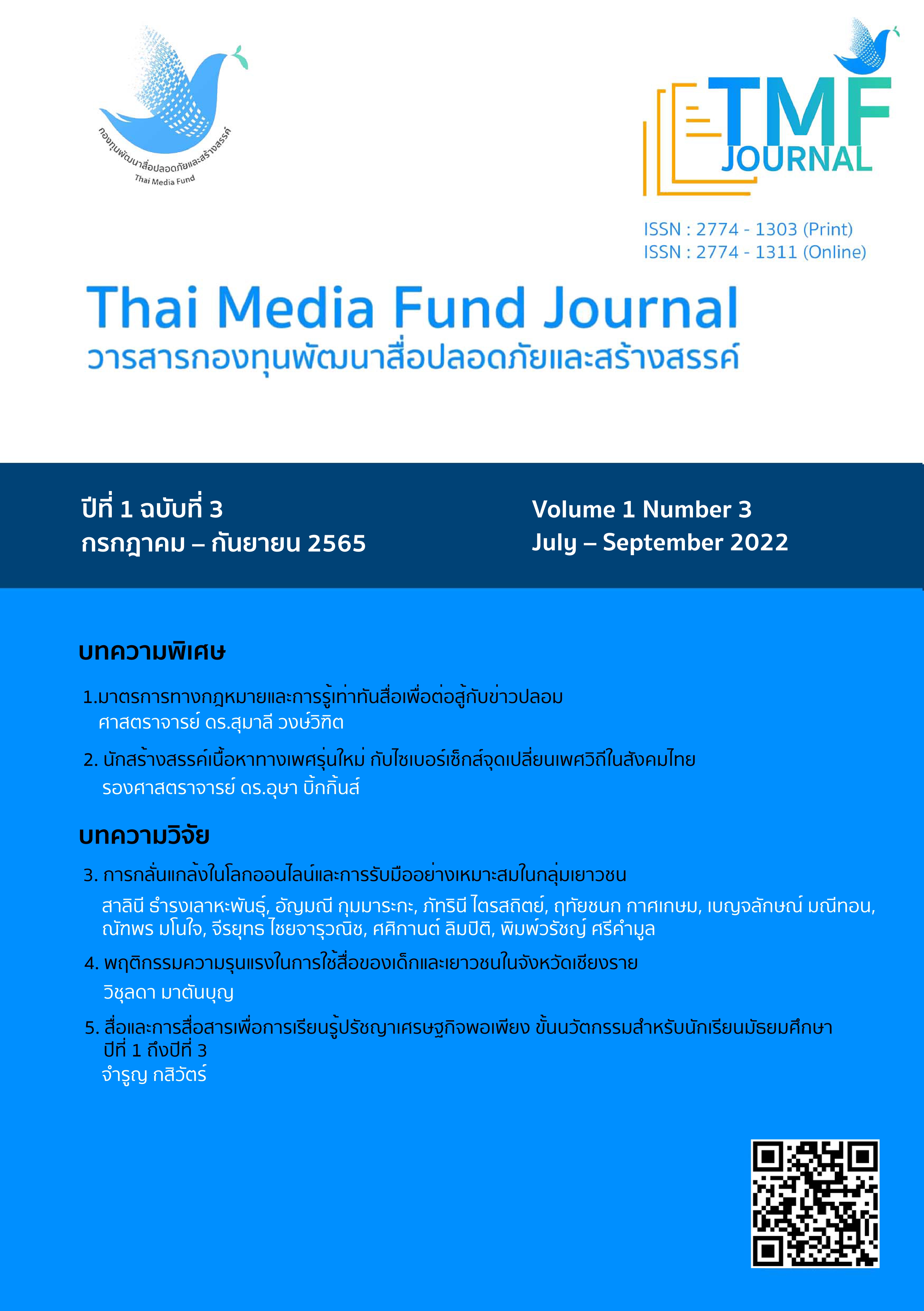การกลั่นแกล้งในโลกออนไลน์และการรับมือ อย่างเหมาะสมในกลุ่มเยาวชน
Main Article Content
บทคัดย่อ
โลกออนไลน์เป็นช่องทางการสื่อสารที่มีความสำคัญในปัจจุบัน ขณะเดียวกันเป็นโอกาสให้เกิดการกลั่นแกล้งในโลกออนไลน์ที่สร้างความเสียหายหรือทำร้ายความรู้สึกผู้อื่น การศึกษาในครั้งนี้แบ่งออกเป็น 2 ส่วน คือ การศึกษาเชิงเปรียบเทียบปัญหาการโดนกลั่นแกล้งในโลกออนไลน์จากการทบทวนวรรณกรรมและการจัดอบรมเชิงปฏิบัติการ โดยมีวัตถุประสงค์เพื่อถ่ายทอดความรู้และศึกษาประสบการณ์การถูกกลั่นแกล้งในโลกออนไลน์จากตัวอย่างนักเรียนและนักศึกษาในจังหวัดเชียงใหม่ 6 สถาบัน ได้แก่ โรงเรียนฝางชนูปถัมภ์ โรงเรียนสันทรายวิทยาคม โรงเรียนมงฟอร์ตวิทยาลัย มหาวิทยาลัยเชียงใหม่ มหาวิทยาลัยการกีฬาแห่งชาติ วิทยาเขตเชียงใหม่ และ มหาวิทยาลัยราชภัฏเชียงใหม่ ผลการศึกษาเชิงเปรียบเทียบ พบว่า ความถี่ของการเกิดการกลั่นแกล้งในโลกออนไลน์ในประเทศไทยและต่างประเทศ
ไม่แตกต่างกัน โดยปัจจัยที่มีความสัมพันธ์กับการกลั่นแกล้งในโลกออนไลน์ ได้แก่ เพศ อายุ การใช้อินเทอร์เน็ต ปัจจัยด้านจิตวิทยา รวมถึงผู้ปกครอง
เมื่อถูกกลั่นแกล้งในโลกออนไลน์ ผู้ถูกกลั่นแกล้งจะได้รับผลกระทบทั้งด้านจิตใจ ความรู้สึก สังคมและการเรียน นอกจากนี้ผลการศึกษาพบว่า นักเรียนมีคะแนนก่อนเข้าร่วมอบรมสูงกว่านักศึกษา และหลังจากเข้าร่วมอบรมเชิงปฏิบัติการ
ทั้งนักเรียนและนักศึกษามีความรู้ความเข้าใจเกี่ยวกับการกลั่นแกล้งออนไลน์มากขึ้นอย่างมีนัยสำคัญทางสถิติ ผลจากการอบรมเชิงปฏิบัติการสะท้อนให้เห็นผลสัมฤทธิ์ของการให้ความรู้ความเข้าใจในการกลั่นแกล้งในโลกออนไลน์ ดังนั้นการให้ความรู้และถ่ายทอดวิธีการรับมือกับปัญหาอย่างเหมาะสมจึงเป็นช่องทางสำคัญที่จะช่วยลดปัญหาดังกล่าวลงได้
Article Details

อนุญาตภายใต้เงื่อนไข Creative Commons Attribution-NonCommercial-NoDerivatives 4.0 International License.
เอกสารอ้างอิง
Archapetch, N. (2017). Cyberbullying: Aggressive misbehavior and innovation for solution. The journal of Social Communication Innovation), 5(1), 100-106.
Atthajãto, A., & Wattanapradith, K. (2020). 5 institutions for solving thai youth’s cyberbullying based on buddhist peaceful means. Journal of MCU Peace Studies, 8(extra), 357-370.
Bauman, S., Toomey, R. B., & Walker, J. L. (2013). Associations among bullying, cyberbullying, and suicide in high school students. Journal of adolescence, 36(2), 341-350.
Campbell, M., Spears, B., Slee, P., Butler, D., & Kift, S. (2012). Victims’ perceptions of traditional and cyberbullying, and the psychosocial correlates of their victimisation. Emotional and Behavioural Difficulties, 17(3-4), 389-401.
Dangchamroon, A. (2020). Teacher, Department of curriculum and instruction, Ramkhamhaeng, University. Interview. April, 13.
IBM Corp. Released. (2017). IBM SPSS statistics for windows, version 25.0. Armonk, NY: IBM Corp.
Kowalski, R. M., & Limber, S. P. (2013). Psychological, physical, and academic correlates of cyberbullying and traditional bullying. Journal of Adolescent Health, 53(1), S13-S20.
Kowalski, R. M., Giumetti, G. W., Schroeder, A. N., & Lattanner, M. R. (2014). Bullying in the digital age: a critical review and meta-analysis of cyberbullying research among youth. Psychological Bulletin, 140(4), 1073-1137.
Kwamkanung, J., & Kaewchinda, M. (2016). Counseling with stabililization techniques to enhance coping skills for cyberbullied youth. Journal of Graduate Studies of Valaya Alongkorn Rajabhat, 10(2), 40-52.
Office of the Broadcasting Commission Television Business and the National Telecommunications Commission. (2020). Report on the results of a survey of Internet data about Internet users in Thailand (2020). Retrieved from http://webstats.nbtc.go.th/
O'Keeffe, G. S., Clarke-Pearson, K., & Council on Communications and Media. (2011). The impact of social media on children, adolescents, and families. Pediatrics, 127(4), 800-804.
Patchin, J. W., & Hinduja, S. (2011). Traditional and nontraditional bullying among youth: A test of general strain theory. Youth & Society, 43(2), 727–751.
Pokaew, D. (2020). Graduate students, faculty of education: Mahachulalongkornrajavidyalaya, University. Interview. April, 8.
Pokpong, S., & Musiphan, W. (2010). Factors affecting attitudes and behaviors of physical violence and bullying through cyber world of thai adolescents. Nakornprathom: Mahidol University.
Saejew, P. (2020). Managing director of B.T. Striker Digital Co.,Ltd. Interview, January, 5.
Schenk, A. M., & Fremouw, W. J. (2012). Prevalence, psychological impact, and coping of cyberbully victims among college students. Journal of School Violence, 11(1), 21-37.
Sirirassamee, T., & Sirirassamee, B. (2015). Health risk behavior among thai youth: National survey 2013. Asia Pacific Journal of Public Health, 27(1), 76-84.
Sittimongkol, R. et al. (2018). An application of logistic regression to the study of cyberbullying behavior of students in department of mathematics and statistics, Thammasat University. Thai Journal of Science and Technology. 7(1).
-12.
Surat, P. (2018). Causes and effects related with cyber bullying: A case study of cybervictim thai youths. Journal of Suvarnabhumi Institute of Technology, 4(1), 260-273.
Tokunaga, R. S. (2010). Following you home from school: A critical review and synthesis of research on cyberbullying victimization. Computers in Human Behavior, 26(3),
-287.
UNICEF. (2016). Ending the torment: Tackling bullying from the schoolyard to cyberspace. Access 16 December 2019, Retrieved from https://violenceagainstchildren.un.org
Whittaker, E., & Kowalski, R. M. (2015). Cyberbullying via social media. Journal of School Violence, 14(1), 11-29.
Yathongkham, W. et al. (2020). Analysis of cyber-bullying messages on youtube websites by using text mining techniques. In The 16th National Conference on Computing and Information Technology, Bangkok. Thailand.


